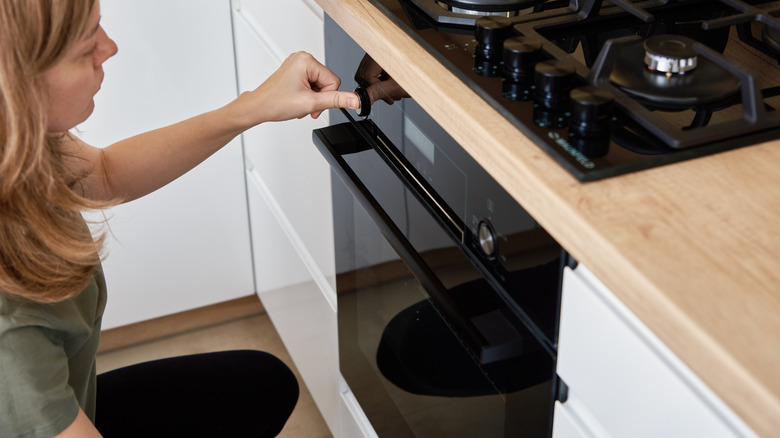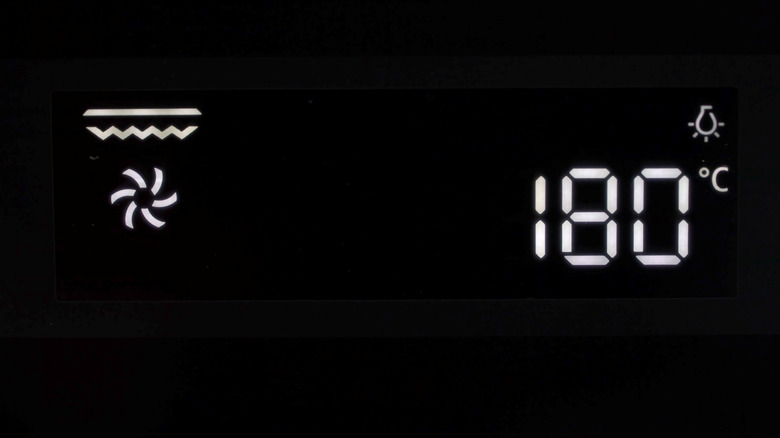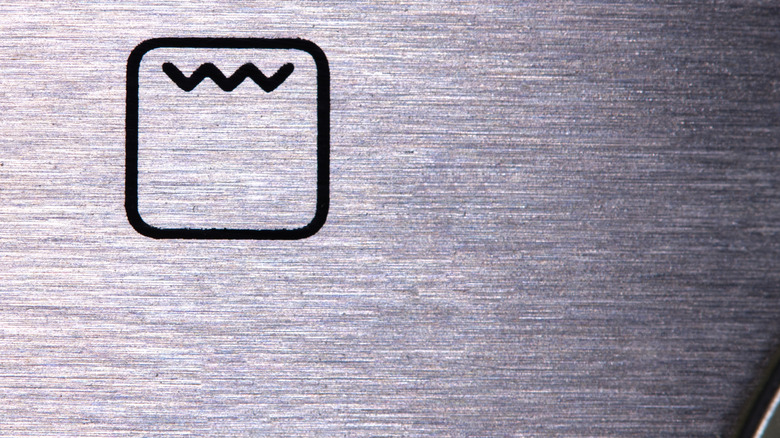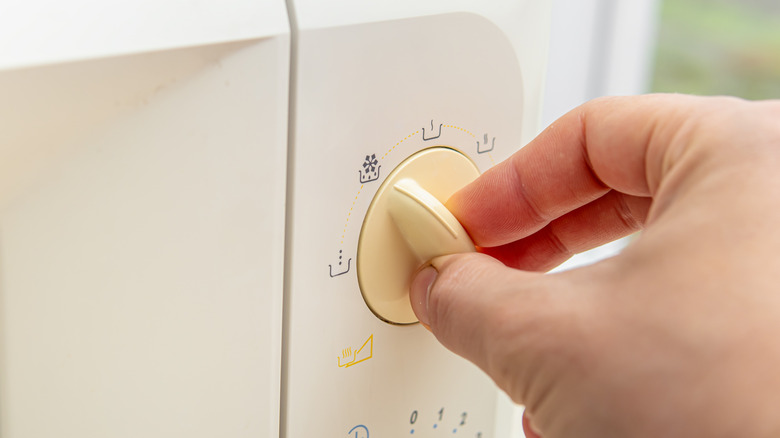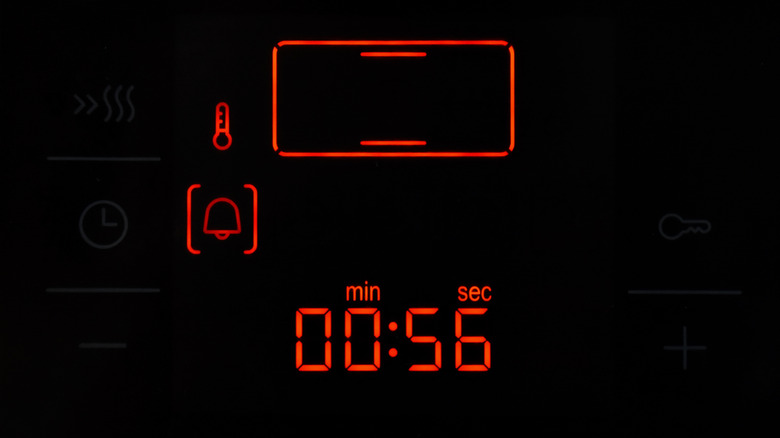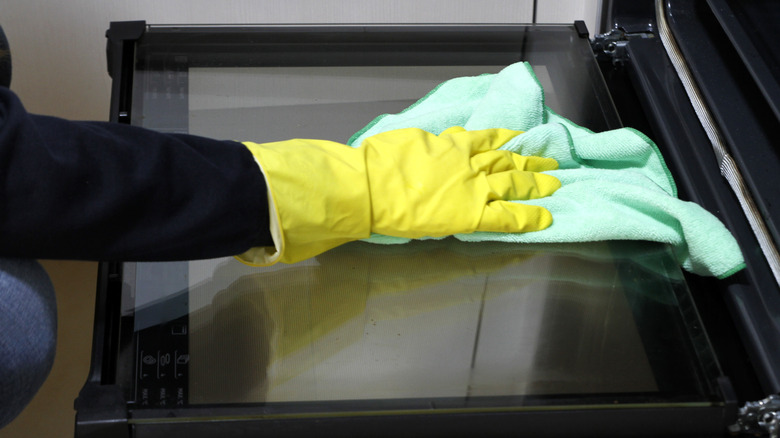How To Understand What Your Oven Settings And Symbols Mean
An oven is a necessity in most U.S. households, with around 70% of Americans owning the appliance (according to data from Statista). After all, it's a nifty device to cook entire meals, bake delicious cakes, and bring frozen foods (pizza, anyone?) to life. However, it can be overwhelming to decode the dozens of symbols and settings and use them appropriately. For instance, you might not know that squiggly lines inside a square resemble the grill setting. Similarly, a fan sign might look out of place, but can be of help when you want to prepare your dishes quickly and evenly.
Not recognizing common settings will put you at a disadvantage since you'll miss out on all the amazing features of this multi-purpose appliance. Worse, you'll have to spend more time and energy preparing a dish than you'd have to if you actually knew about the settings. For example, you might rely on time-consuming methods to defrost frozen meat instead of popping it in the oven to speed up the process. You'll miss out on the safety and cleaning features as well. To ensure you make the most of your oven, here's a list of the most common symbols you should know for cooking and grilling food, to save time and effort, to clean the appliance, or for using the device with safety precautions.
Common oven symbols you should know for cooking food
A fan in a circle (or just a fan if you have a combination oven) is one of the first signs you should recognize when using your oven to cook food. Popularly recognized as the fan-forced or convection setting, this sign will help evenly spread hot air and prevent concentrated hot spots. This ensures the food gets cooked per your desires regardless of its placement. Simply put, anything on the first shelf will receive as much heat as items on the second and third racks. The fan-forced mode reduces cooking time and energy consumption.
Another symbol worth knowing is the fan grill or fan assist. It features a fan with zig-zag lines on top, indicating the grill feature. Perfect for basic roasting and cooking poultry that requires a lot of time, the fan ensures the grill's heat is spread consistently within your oven. The grill turns on and off constantly to maintain the heat inside the box and keep things from overcooking. Next is the fan with the bottom heat, indicated by a straight line under the fan. Known as the pizza symbol, it's ideal for cooking items that require heat from below without concentrated heat burning the toppings on the surface, like pastry dishes and pizza. Similarly, a line at the bottom of a square enclosure shows the bottom element will be responsible for cooking your dish. The opposite is true for a sign with a line at the top. An enclosure with lines at the top and bottom is known as the conventional symbol and uses both elements to cook your food.
Symbols to note when grilling
Being familiar with the symbols used for grilling will make it easier for you to grill vegetables, meat, sausages, and steaks to a restaurant-like finish. For starters, a zigzag line (or two) within an enclosure stands for the full grill option. This setting will help you cook food in large quantities, so you don't spend the majority of the holidays or social gatherings preparing a feast. Use the setting for its intended purpose or to add a delectable brown layer on your lasagna, pie, or sandwich.
The center (or partial) grill symbol is represented by a short zigzag line at the top of a square enclosure. In case your oven has two jagged lines to represent the grill mode, a single line will stand for partial grill. This setting uses the middle of your oven's grill to cook food or brown solo dishes. However, placement is key when using this mode, so ensure your dish is smack dab in the middle of the rack to take advantage of the partial grill symbol. Another grill-related symbol you might encounter is the grill with bottom heat. It comes with a grill sign (squiggly line) on top and a straight line at the bottom. This combines the heat from the bottom element with the grill, and is best for dishes that can do with a crispy top and a well-cooked base, like casseroles.
How to decode time-saving symbols
Your oven isn't just a great appliance to cook food. It can save you time and effort, too. For instance, the defrosting symbol, indicated by a snowflake (or frost) over a water droplet, is great for softening frozen food items. This setting employs low temperatures , often using the oven fan with no heat, to speed up the thawing process without allowing bacteria room to grow. However, not all ovens feature this setting. Another setting that'll save you time and energy is plate warming. The setting is depicted by stacked plates and generates low heat. It'll come in handy when you have guests over and would like to serve them food on warm plates without worrying about damaging them.
Tired of reheating each dish because your partner is forced to pull another late night at the office? Or, maybe, you wait to serve your kids hot dinner before leaving for a social engagement? Whatever the case, the food or oven warming (also known as reheating) setting will make things easier for you. Indicated by three squiggly steam lines rising from a dish, it's perfect for keeping food warm for consumption. Remember, it doesn't cook food further, so don't use it if you have a half-baked dish in mind. The oven light mode is useful when you want to quickly check on the progress inside without pausing the current cycle and opening the door. Represented by a lightbulb, this symbol won't impact the food cooking inside.
Symbols that can help to keep you safe
One of the most underrated and useful oven symbols for safety is child lock. This is because it prevents children (or notorious pets) from turning on the appliance or making changes to your set programs. Look for a key or lock in a square to activate the lock. Another oven symbol that'll keep your food from burning is minute-minder. Represented by a clock sign, this setting lets you set a cooking period for your food. As soon as the time is up, your oven will sound a beep or another sound, depending on the brand and model, and stop cooking the popped in dish.
Further, the alarm or timer symbol comes in handy, especially if you're cooking and baking multiple dishes at once and need to check on their progress every few minutes. This is because you can set a timer for the dish and your oven will sound an alarm when the set cooking cycle comes to an end. Press the bell icon to use this setting and prevent house fires this holiday season. However, unlike the minute-minder symbol, it won't turn off the oven, so don't let your dishes marinate after an alarm.
What symbols you should pay attention to when cleaning
While avoiding a few popular oven cleaning hacks will save you from disappointment and headaches down the line, you might want to give your oven's self-cleaning feature a try. But before you get excited, remember that you can only opt for this setting if you have a self-cleaning oven. If you aren't sure, see if there's a button with lots of circles arranged in 3x3 format or arrowheads on it or with the letter 'P.' Once you push this button, your oven will reach high temperatures (between 800 and 900 degrees Fahrenheit) and turn the food remnants to dust. After the cycle is through and the appliance has cooled down, you just need to wipe down your oven to unveil its sparkling interior.
In case you need to take care of trivial spills and food residue in your oven, opt for the steam clean setting. Signified by a button with five water droplets, the letter 'V,' or a small fan over a small drop of water, this mode uses steam to clean the appliance. Basically, it combines heat lower than the temperatures achieved during the self-clean cycle and moisture to dislodge the mess from the cavity, making it easier for you to wipe it all away.
